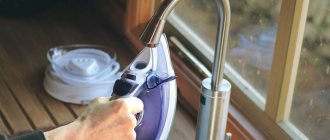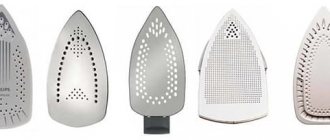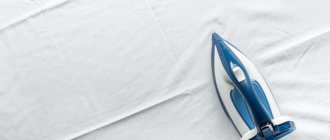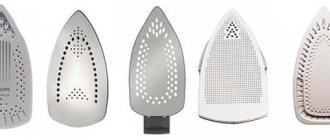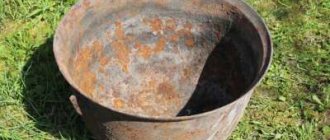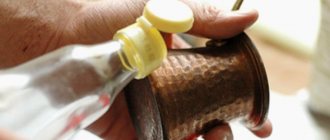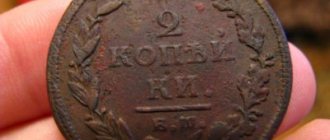Features of internal cleaning
Brown liquid flows out of the iron
If the iron spits rust, this may be due to the internal elements of the silicone steam generator becoming unusable. These parts are gaskets between the water tank and the base of the device.
- During prolonged use, the sole becomes hot. At the right time, the thermostat, which turns off the iron to prevent excessive overheating, does not work.
- The metal heats up to such an extent that it begins to affect the insulation of the silicone steam generator chamber.
- At a heating surface temperature of about 300 degrees, even heat-resistant silicone material melts.
- The iron begins to spit out brownish liquid. This is not rust, but molten silicone, similar in color to it.
It is necessary to replace a thermostat that has stopped working. The new unit will allow you to get rid of excessive overheating of the metal elements of the iron. If this is not done, the device may become unusable.
Real rust occurs not only due to poor quality water, but also due to a violation of the insulation of metal elements from moisture inside the steam generator chamber. If they are corroded, there is no point in repairing the device. If it’s just a matter of rusty or moldy stains due to bad water, the iron can be used quite well after proper cleaning.
Prevention of the problem
To avoid problems in the future use of your irreplaceable assistant, follow a few simple rules common to all models of steam generator-type irons:
- Fill the inner chamber only with distilled water. If it is impossible to get it, use it, at least boiled.
- Never leave moisture in the iron's internal reservoir because it will encourage rust. Always try to evaporate all the water before turning off the appliance.
- After finishing ironing, leave the iron in an upright position. This prevents the corrosion process and clogging of the steam holes;
- Do not wind the iron cord too tightly, especially while the device is still warm.
- Follow the operating instructions carefully.
Proper care and compliance with operating rules will extend the life of the device and eliminate sudden breakdowns.
Cleaning accessories
Some models have a special self-cleaning system. For this purpose there is a special button located on the body of the device. According to the manual, heat the device to the required temperature. To start the cleaning process, press the button.
With such a system, any housewife will be able to clean the device without effort.
If rust and scale are not washed out of the iron, it is disassembled and all parts are washed manually. If you do not completely trust your knowledge of technology, it is better to entrust this activity to a professional.
Errors during operation
In addition to those listed, there are other reasons for water running onto the laundry.
- When using a steam generator with a free-standing water tank, you may be placing it above the level of the ironing board or on the board itself. In this case, boiling water will enter the hose and flow down it, forming a water plug. Steam, trying to pass under pressure to the outlet, pushes this plug forward. This is how drops form on the sole. This is not a breakdown, don't be afraid. You need to move the base under the board. Place a stool or something similar nearby, then splashes of boiling water from the base, even if they get into the hose, will flow back and the steam will escape unhindered.
- If you iron often and a lot, and begin to notice that the laundry becomes damp during ironing, then the reason may be hidden in the ironing board itself. It may happen that the coating on it has worn out, and as a result of powerful steaming, liquid began to accumulate in the ironing table. Solution: Renew the cover of the board under the cover.
Household chemicals
Anti-scale for irons Un Momento, super concentrate
If brownish or whitish stains appear on the sole, different from an ordinary burn, you can use Anti-scale. The process is simple. Following the instructions, dilute the product in water, then pour it into a container and heat the iron strongly. Turn it off and wait about 30 minutes. Drain the contaminated liquid and clean the container with clean water.
German-made compounds containing organic acids and anti-rust components also help: Topperr, Bosch, Filtero 605.
To clean the iron from rust inside with such preparations, follow this procedure:
- Dissolve the product in water in a ratio of 3:1.
- Preheat the iron by setting the control to maximum, and then turn it off.
- Pour the composition into the water inlet, place the device horizontally and wait 2 hours.
- Pour out the product and rinse the inside a couple of times with water.
Immediately before ironing, check the cleanliness of the appliance by releasing steam.
The drug “Silit” perfectly removes corrosion and scale. To clean the iron, you need to turn it upside down and carefully pour the cleaning agent drop by drop into the sole holes. After a few minutes, traces of rust will appear on the outside. Remove them with a dry cloth, then add water, and press the steam release buttons several times.
How to properly pour water into an iron
To fill the reservoir, there is a special cup with a narrow spout, which is included with the appliance. If the container is lost, you can replace it with a similar object or funnel. The inner walls had to be clean so that no foreign substances could get into the tank.
Before adding water, you need to read the instructions for the procedure. Since different models of irons are designed differently, even from the same manufacturer, the method of filling the reservoir may vary. General recommendations are as follows:
- Disconnect the iron from the power supply.
- Depending on the model of the iron, place it vertically or on the soleplate.
- Set to “no steam” position.
- Open the reservoir lid.
- Pour in water from a measuring cup. During filling, it must flow continuously so that an air lock does not form.
Be especially careful when pouring water into a hot iron. If the jet is too strong or wide, it will cause boiling water to escape and cause burns.
- Check the water level: it should not exceed about 0 on the housing.
- Close the lid and turn on the iron.
- Set the steam mode and start ironing.
- If the model is equipped with a removable reservoir, then before removing it for filling, the iron must be turned off.
Folk remedies
You can also clean your ironing device from traces of corrosion, lime and fungus using traditional methods. Mold marks will go away if you use recipes against rust and scale, but to remove mold forever, it is better to choose specific products.
Recipes against rust and scale
Cleaning the iron with vinegar
If the appliance spits out rusty liquid, or white scale stains remain on the fabric, compounds with high acidity are used. Usually vinegar or citric acid is used, but you can also use sparkling water.
Cleaning the device with vinegar:
- Pour vinegar mixed with water in equal parts into the iron, about a third of the capacity.
- Place the iron vertically and heat it to maximum, wait 5-10 minutes. During this time, the heating and cooling cycle will repeat, do not turn it off.
- Lift the appliance horizontally above a large bowl and press the steam release button. As a result, rusty liquid should flow out of the plantar holes. Let the steam flow until all dirt comes out of the ironing device.
- Fill the reservoir with clean water and heat the machine again to get rid of any remaining dirt and vinegar. Once or twice, without removing the basin, let off the steam.
Finally, pour out the water and wipe the surface and holes with a clean cloth.
Citric acid is even easier to use because it does not produce such unpleasant-smelling fumes as vinegar. You need to dilute a 25-gram package in 250 ml of warm water until completely dissolved. Then heat the iron and pour in the resulting mixture, wait 5-10 minutes.
Draining dirt from the iron
Hold the device in a horizontal position over a basin and release steam several times so that dirty liquid comes out of the holes. After removing it, you need to pour out the liquid, pour in clean water and perform the same steps to remove any remaining scale. Then dry the sole and holes with a piece of cotton cloth.
It is safest to clean your iron with carbonated water. It is used not only for ironing equipment, but also for washing machines and kettles. You must proceed as follows:
- Fill the reservoir with water and heat the device at high temperatures.
- Disconnect from power supply.
- Shake the device.
- Place a piece of cotton under the iron and press the steam release button several times.
- Pour out the remaining water when the appliance has cooled completely.
Perform the manipulation several more times until completely cleaned.
Mold control compounds
An effective remedy for mold in the iron is tea tree oil.
Spots with a brownish, gray or greenish tint remaining on the fabric indicate the appearance of mold in the water compartment, and bright green spots indicate the growth of algae.
Ways to clean the inside of an iron from mold at home:
- Bleach. When preparing the solution, take one part of the drug to ten parts of water. The resulting composition is poured into the container. After about five minutes, the steam function turns on and the dirt comes down through the holes. Finally, the container is rinsed with boiled water.
- Ammonia. You can achieve the effect by making a mixture of water and alcohol and filling the water compartment with it for several hours. The solution is removed using the steam extraction function. Additionally, the steam outlets are cleaned. After cleansing, ammonia is washed off with boiled water.
- Hydrogen peroxide. The drug is poured into the water compartment, after ten minutes it can be cleaned. To speed up the process, use a narrow, hard brush.
- Tea tree oil. Enough 10 drops per 20 ml of water. The composition is poured into the reservoir of the device. Then you need to remove the liquid through the steam holes.
An old effective remedy is baking soda. It is non-toxic and gently acts on the walls of the container, removing mold bacteria and algae. The advantage of this method is that soda is able to absorb moisture, thereby preventing the further appearance of microorganisms. Clean the tank with an aqueous solution at the rate of 1/4 large spoon of powder per glass of boiled water.
Borax has proven itself in the fight against mold.
If the water container is covered with algae that forms a green coating, it is cleaned with borax. It is a natural, chemical-free, non-toxic product suitable for cleaning drains and toilets. Can be used as an insecticide in the fight against mold.
To remove greens from the device’s reservoir, you must:
- dilute 200 ml of the drug in 2.5 liters of water;
- Fill the container with the solution and clean it with a stiff brush;
- remove the remaining composition with purified water.
One rinse is enough to remove excess solution. The product remaining on the surface of the tank is not removed, as it will prevent the growth of bacteria.
Self-cleaning function
The newest models have a self-cleaning function that must be used periodically. Now you will find out how to do this.
- Fill the container to the maximum.
- We set the maximum temperature without turning on steaming.
- We place a basin under our iron and shake it.
- We activate the self-cleaning mode by pressing the button. Don't be alarmed if some liquid leaks. This means that you did well, you did everything right, and your iron was cleaned.
Let it cool, then rinse.
What to do with scorch marks
You can remove scorch marks without chemical exposure under certain conditions. Stains on dense, thick materials are removed using sandpaper, a manicure file, a razor, or pumice. Using mechanical action, the top layer of jeans with burnt particles is removed. Be careful not to stretch the fabric when scraping.
Small traces can be removed by steaming. Prepare gauze and towel. Place the damaged clothing on a towel, moisten the gauze, fold and cover the items. Steam the damaged area several times, being careful not to press the iron.
Useful tips
The success of the procedure for removing rust from white clothes depends on following simple but important rules :
- Before removing stains, it is recommended to clean the clothes from dust and remove all metal parts.
- Read the recommendations on the product label.
- You should not wash the item until the stains are removed.
- Rust should be removed immediately after it appears.
- The cleaning agent is applied to the reverse side of the item.
- After removing the stain, wash the clothes in the manner recommended for this type of fabric.
- Once stains have been removed, clothing should not be washed with other items.
The use of household chemicals or home solutions with aggressive components requires the mandatory use of rubber gloves. When using chlorine-containing compounds, you must use a respirator.
You will find a lot of useful information about rust removal in this section of the site.
Method 1. How to remove rust stains from clothes using glycerin and chalk
Before removing new rust stains, the item must be washed; it is advisable to use conditioner when washing. After this you need:
- for cleaning you need to prepare a mixture (mix the components in equal proportions: 100 g of chalk and 100 ml of glycerin in 60 ml of water);
- moisten the contaminated area and apply the prepared mixture to the area of fabric with the stain;
- place the product in a plastic bag (usually leave for 10-12 hours);
- dry the fabric at a temperature of 18-20o C;
- Finally, wash the product using laundry soap. The result will please you.

